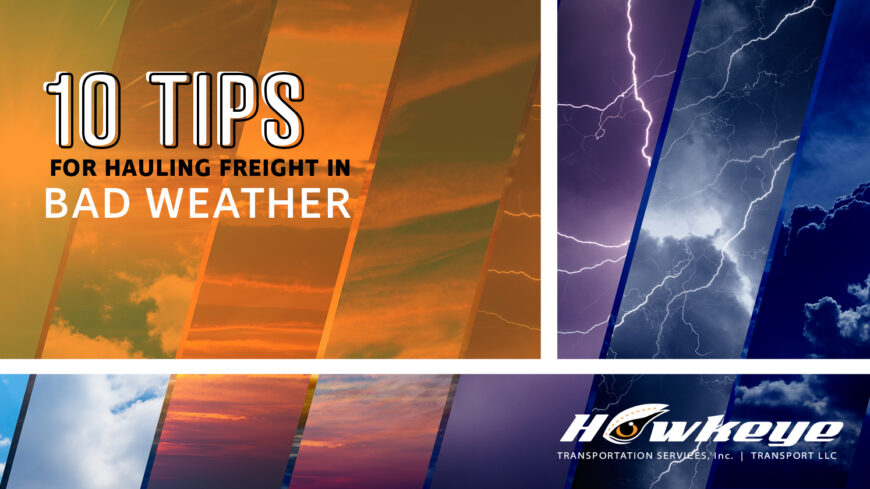No matter the time of year, the weather is constantly changing, especially for drivers traveling over great distances.
You could be driving down a road with nothing but clear skies when suddenly a storm hits. This creates a major hazard to the driver and could even jeopardize your career if you got into a wreck.
Bad weather can make for frightening driving conditions, no matter how much experience a driver has. Here are ten tips to remember the next time you get behind the wheel of your rig.
1. Check the weather forecasts on your route.
Before starting your trip, the first thing you should do is check the weather forecast. That way, you know exactly what to expect. Check the local news, search online, or use a weather app to check the weather to ensure that you don’t run into any serious problems on the road.
Pro tip: Before hitting the road, check with state transportation and highway patrol departments to find out about possible commercial vehicle restrictions. Sometimes, certain highways are off-limits to big rigs for periods of time when extreme winter storms are forecast.
2. Empty trailers are more dangerous than you think.
When a trailer isn’t loaded with freight, there is an increased risk of being blown over. Even if the truck does not tip over from the winds, it still can shake from side to side, causing issues for other drivers on the road. Not to mention it’s hard driving a truck that is not steady.
Pro tip: If you can, make sure that you always have at least some weight in your trailer to prevent possible tip-overs.
3. Do a full pre-inspection of your truck and trailer.
The most important part of your trip is to ensure that everything is in order before hitting the road. Take time to pre-inspect your truck for anything that could be hazardous when on the road. Make sure your tread is deep, tires are filled, wiper blades are functioning, exhaust pipe is cleared, lights are working, and your truck/trailer is ready to hit the road.
4. Drive slowly…
When caught in bad weather during a delivery run your first instinct may be to rush through the weather so you can finish the job on time. While your intentions may be good, this is incredibly risky and unsafe. You must always remain cautious when driving in bad weather to prevent a wreck. …and turn slowly. Make sure your turns are slow and controlled. Wheels lose traction easily in inclement weather conditions like rain, snow, or ice.
5. Stay in your truck.
There are times when you’re in the middle of a run, and the weather gets too rough to continue safely. To continue driving is too dangerous. On the other hand, if you try to find shelter, you may not find anything for miles. Whether it’s because of a harsh blizzard, strong winds, or other extreme weather, the best thing to do is to pull over onto the side of the road and wait it out in your truck.
6. Brake and accelerate gently.
If you find yourself stuck in extremely harsh weather, remember not to slam on your brakes or gas. If you do, you risk your tires locking up and spinning out of control. Furthermore, when rain mixes with the paved road, it creates a slippery surface that makes it easy for your tires to lose traction. Stay mindful and gently tap your brakes/gas as needed.
7. Give everyone a little extra space…
If you are driving in a storm, make sure there is enough room between you and other vehicles in case you have an emergency and need to pull over. It takes a lot more effort to pull a semi-truck over than it does for any other vehicle, so make sure that the roads are relatively clear enough. …and increase stopping distances. Trucks need a lot more room than other vehicles to come to a stop and stopping distances increase even more on wet roads.
Pro tip: Wet leaves on the ground are almost as slippery as ice, so be aware of the roads you’re traveling.
8. Watch out for black ice.
When driving during the winter, you face serious risks on the road; one major risk is black ice. It can be difficult to see on the road, especially when you are sitting higher up from the road than other vehicles. You need to be wary of the black ice which only appears when temperatures are close to freezing.
Pro tip: Some signs to look for are ice build-up on mirror arms, antenna, or the top corners of your windshield.
9. Be extra cautious on inclines…
If you are traveling uphill, make sure to be extremely careful, especially if your view is obscured by bad weather. When approaching higher elevations, you may experience changes in weather such as heavy wind gusts and a steep drop in temperature that could impact your tires. Take your time when going uphill. …and bridges. Oftentimes bridges will have more ice on them than other sections of the road, so be wary when approaching a bridge.
10. Always pack emergency supplies.
Make sure you prepare for the different weather conditions you will face before you start your run. Also, make sure you have emergency supplies packed in case you get stranded.
Pro tip: Pack a bag with supplies for emergencies; extra set of warm clothes, snacks, water, a flashlight, batteries, etc.
There is always risk of unexpected events which affect and cause the disruption of the flow of materials in their journey. To mitigate the risks related to supply chain & logistics, there are safety measures that can help reduce the risks or impact. We take great care to ensure the safety of your load, our drivers, and our employees.
We ensure that all our employees are highly trained, and our transportation expertise in refrigerated freight means you are working with a partner who knows how to handle your cargo. Hawkeye is the qualified transportation partner you have been looking for to trust your freight to.
CONTACT US today to get your load on the road.
Sources:
https://unitedtruckschool.net/10-tips-driving-inclement-weather/
https://convoy.com/blog/weather-safety-tips-for-truckers/
https://www.freightwaves.com/news/how-truckers-can-weather-snow-squalls



